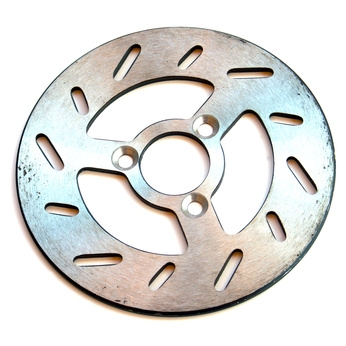
Four-wheel disc brakes have become more common in vehicles because of their increased stopping power. Disc brakes are a reliable system, but still need routine maintenance. In addition to replacing the brake pads as they wear, a technician must make certain that the brake rotors are within certain standards to stop the vehicle operating in a smooth and reliable manner. Some key measurements must be taken and compared to the manufacturer's allowable specifications.
A brake rotor has a specified minimum thickness. The brake rotor must measure thicker than the manufacturer's minimum or discard thickness after the technician has finished resurfacing the rotors. Normal braking action can cause wearing of the rotor surfaces. Scoring or corrosion can affect the thickness as well, because more metal may need to be removed from the rotor to provide a suitable braking surface. A technician measures the brake rotor thickness with a micrometer in either thousandths of an inch or hundredths of a millimeter. Usually the minimum rotor thickness is stamped on the brake rotor for easy reference. If the rotor is too thin, it will not dissipate heat correctly and be more prone to warping.
The brake rotor consists of two braking contact surfaces that must be parallel with each other, or else the brakes will pulsate when they are applied. In order for a technician to determine if the surfaces are parallel, he must take four measurements of the rotor thickness over 180 degrees, or half the surface of the rotor. If the measurements are not equal, the rotor will need to be machined to restore the parallel surfaces. The technician will machine the rotor on a lathe that is designed to precisely remove material to produce two smooth surfaces that are parallel with each other and to the hub-mounting surface. The problem with thickness variation is that too much material may need to be removed to establish these surfaces, leaving the rotors below the minimum thickness and therefore unserviceable.
The brake rotor attaches to the hub of the vehicle. If the rotor is within specifications, the rotor will spin true without wobbling outside of an imaginary plane drawn through the hub and parallel to it. If it does wobble, the rotor may either need to be machined or replaced. The problem may also be that the rotor is not fastened to the hub of the vehicle completely, or debris or corrosion may be between the hub and the rotor, causing this runout. A technician will correct runout by completely cleaning the surfaces where the hub and rotor meet. The rotor may also need to be resurfaced or replaced. Resurfacing the rotor with a special on the car brake can match the hub and the rotor to restore that true rotation within the plane. Lateral runout is measured with a special type of micrometer called a dial indicator that is clamped onto a solid part of the vehicle. The technician spins the rotor on the hub and measures how far outside of the flat plane the rotor travels.
Brake rotors can develop grooves in their surfaces as part of normal brake wear. A technician measures these grooves using a micrometer, which they insert into the groove. Then the normal flat surface thickness is measured. The smaller number is subtracted form the larger, revealing the groove depth. Generally, if the grooves are deeper then 0.1 mm, the rotor should be replaced.